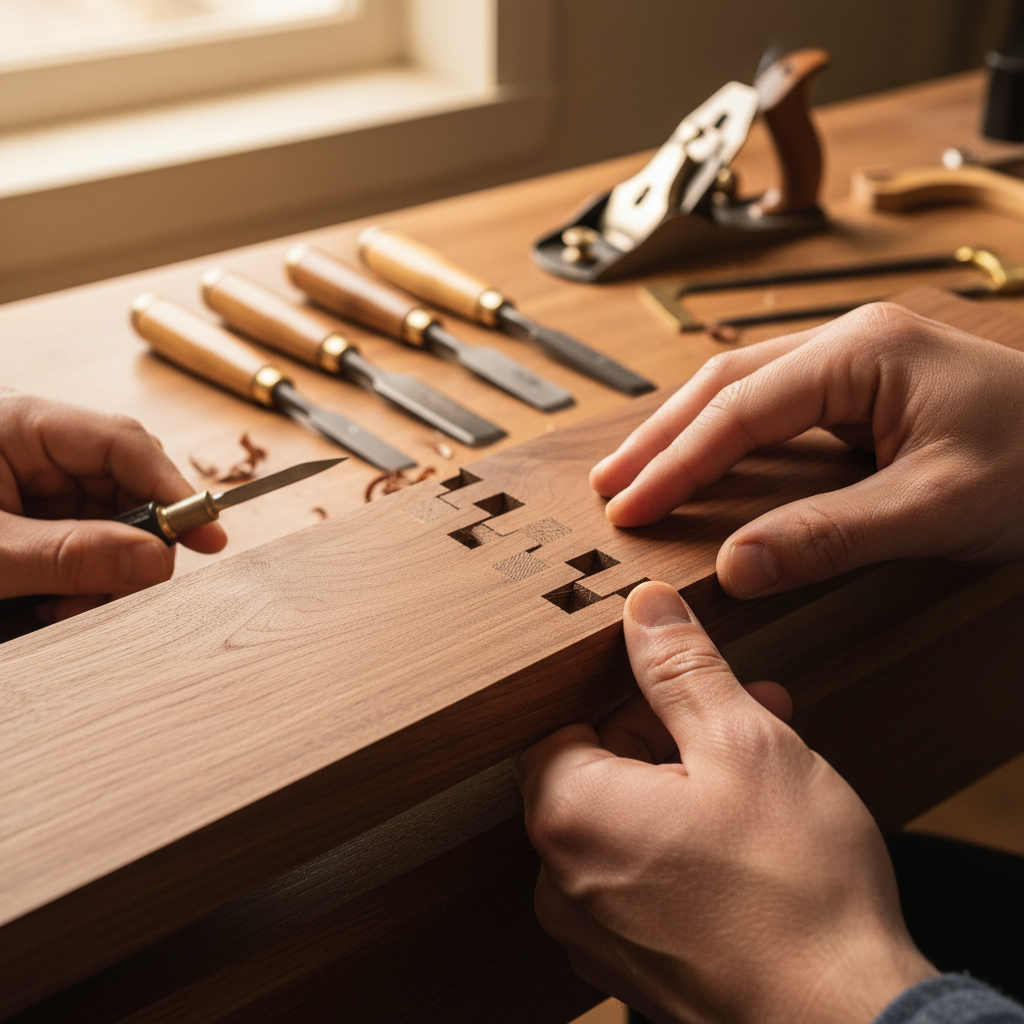Hey there, fellow woodworker! Remember that thrill when you first successfully glued two pieces of wood together, maybe with a simple butt joint or a basic dado? It was a start, right? But if you’re anything like me, after a while, you start looking at those beautiful, heirloom-quality pieces in magazines or online and think, “How do they get their projects to look so incredible and last for generations?”
The secret, my friends, often lies in advanced joinery. No offense to the humble butt joint, but there’s a whole world of intricate, incredibly strong, and aesthetically pleasing coections just waiting for you to discover. And here’s the best part: they’re not just for professional cabinetmakers or old-school artisans. With a bit of patience, the right tools (which you probably already own most of!), and a willingness to learn, you, a hobby woodworker, can absolutely master these techniques and elevate your craft to a whole new level.
I remember my first attempt at a hand-cut dovetail. It was… let’s just say “rustic.” But the satisfaction of seeing those pins and tails interlock, even imperfectly, sparked a fire. It’s a journey, not a race, and I’m here to share some of my experiences and tips to help you on yours. Let’s dive into some advanced joinery techniques that will transform your projects from good to truly exceptional.
The Elegance of Dovetails: Hand-Cut vs. Router Jigs
When you hear “advanced joinery,” chances are the first thing that pops into your head is the dovetail. And for good reason! Dovetails are the gold standard for box and drawer construction, offering incredible mechanical strength due to their wedging action, and an undeniable beauty that just screams craftsmanship.
Why Dovetails?
- Strength: They resist being pulled apart, which is why they’re perfect for drawers that endure constant pulling.
- Beauty: The interlocking pins and tails create a visual rhythm that’s incredibly pleasing to the eye.
- Tradition: It’s a hallmark of fine woodworking that dates back centuries.
Hand-Cut Dovetails: The Zen of Woodworking
There’s something deeply satisfying about cutting dovetails by hand. It’s a meditative process that coects you directly to the wood. It requires sharp chisels, a marking knife, a dovetail saw, and a healthy dose of patience. My first successful hand-cut dovetail, after many failed attempts, felt like a personal triumph! It wasn’t perfect, but it was *mine*.
Tips for Hand-Cutting:
- Sharpening is paramount: Your chisels and marking knife MUST be razor sharp. Dull tools lead to frustration and messy joints.
- Accurate layout: Use a sharp pencil or, even better, a marking knife to score your lines precisely. A good dovetail marker or gauge helps immensely.
- Practice on scraps: Don’t jump straight into your prized walnut. Grab some pine or poplar and practice the sequence: cut tails, transfer to pins, cut pins, chop waste. Repeat.
- Go slow: Rushing leads to mistakes. Take your time, enjoy the process.
Router Jigs: Precision and Production
If hand-cutting isn’t your jam, or you need to churn out multiple identical joints for a larger project, a router dovetail jig is an absolute game-changer. These jigs, like those from Leigh, Porter-Cable, or even simpler ones, allow you to create precise, repeatable dovetails with relative ease once you’ve mastered the setup.
Tips for Router Jigs:
- Read the manual (seriously!): Each jig has its quirks. Understanding the setup and calibration is crucial for perfect results.
- Test cuts: Always, always, ALWAYS make test cuts on scrap pieces of the same thickness and species as your project wood. Adjust the router bit height and jig settings until you get a perfect fit.
- Router bit quality: Invest in good quality, sharp dovetail bits. They’ll last longer and give you cleaner cuts.
- Dust collection: Routing dovetails can create a lot of dust and chips, so good dust collection is a must for visibility and safety.
Whether you choose the hand-tool route or the router jig, mastering dovetails will open up a world of possibilities for your projects.
The Mighty Mortise and Tenon: Strength You Can Trust
When it comes to building sturdy frames, tables, chairs, or anything that needs to withstand significant stress, the mortise and tenon joint is your best friend. This joint, consisting of a ‘mortise’ (a hole or slot) in one piece and a ‘tenon’ (a projection) on the end of another, is incredibly strong and resistant to racking (side-to-side movement).
Why Mortise and Tenon?
- Unrivaled Strength: The long grain to long grain glue surface combined with the mechanical interlocking makes it incredibly robust.
- Versatility: Can be used in countless applications, from furniture frames to door construction.
- Timeless: A classic joint that has proven its worth for milleia.
Creating the Mortise and Tenon
There are several ways to create this joint, each with its advantages:
Hand Tools: The Traditional Approach
Using chisels and a mallet to chop out a mortise is a fundamental woodworking skill. It’s slower but gives you immense control. I find it therapeutic, especially for smaller projects or when I only need a few joints.
Tips:
- Outline accurately: Use a mortise gauge or marking knife to score your mortise lines precisely.
- Start with a drill: Drilling out most of the waste with a drill press before chiseling makes the job much easier and faster.
- Chisel effectively: Work from both sides to prevent blow-out. Pare small amounts at a time.
Power Tools: Efficiency and Precision
- Drill Press with Mortising Attachment: This attachment converts your drill press into a poor-man’s hollow chisel mortiser. It works well for hobbyists, though it can be a bit slower than dedicated machines.
- Router and Jigs: My go-to method for efficiency. A plunge router with an edge guide or a dedicated mortising jig (like a Festool Domino or a dedicated mortising jig you can build or buy) can cut mortises quickly and accurately. For tenons, a router table with a fence and a straight bit works wonders.
- Table Saw: With a dado stack or a series of passes and a tenoning jig, your table saw can cut precise tenons. You can also clean up tenon shoulders with a crosscut sled.
Types of Mortise and Tenon:
- Blind Mortise and Tenon: The most common, where the tenon does not pass all the way through the mortise, hiding the joint.
- Through Mortise and Tenon: The tenon extends through the other piece, often wedged or pied for extra strength and decorative appeal.
- Haunched Mortise and Tenon: A variation used when the tenon is at the end of a rail, leaving a ‘haunch’ to fill the full width of the mortise groove.
Regardless of your chosen method, perfect mortise and tenon joints require careful layout and test fitting. A joint that fits snugly, but not so tight that it needs a hammer to assemble, is ideal for a strong glue joint.
Beyond the Basics: Sliding Dovetails and Splined Miters
Once you’re comfortable with dovetails and mortise and tenons, you might be ready to explore some slightly less common but equally rewarding joints.
Sliding Dovetails: Elegant and Strong
Imagine a dovetail, but instead of interlocking on the end, one piece slides into a dovetail-shaped groove in the other. That’s a sliding dovetail! This joint is fantastic for attaching shelves to cabinet sides, securing table aprons to legs, or even building complex carcases.
Why Sliding Dovetails?
- Exceptional strength: It resists being pulled out and also provides lateral stability.
- Clean appearance: When the joint is hidden, it offers a seamless look. Even when visible, it’s a mark of skilled craftsmanship.
How to Make Them:
Most hobbyists use a router with a dovetail bit. You cut the groove (mortise) in one piece and the dovetail tenon on the mating piece. The trickiest part is getting the fit just right – snug, but not impossible to slide. My advice? Cut the groove first, then slowly sneak up on the fit of the tenon by taking very light passes with the router until it slides in smoothly but without slop.
Tip: If you’re using a router table, a featherboard can help keep consistent pressure for perfectly straight cuts. For long pieces, outfeed support is crucial.
Splined Miter Joints: Reinforcing the Weakest Link
Miter joints, where two pieces meet at an angle (usually 45 degrees for a 90-degree corner), look beautiful because they hide end grain. However, glue applied to end grain isn’t very strong, making standard miter joints fragile. This is where a spline comes in!
A spline is a thin strip of wood inserted into matching slots cut into both pieces of the miter joint. It dramatically increases the glue surface area, providing significant strength and helping to align the joint during glue-up.
Why Splined Miters?
- Strength: Transforms a weak miter into a robust coection.
- Alignment: The spline helps keep the joint perfectly aligned during clamping.
- Decorative potential: You can use contrasting wood for the spline to create a beautiful, exposed detail.
How to Make Them:
You’ll need a table saw or a router table. For a table saw, a simple jig can hold your mitered pieces at a 45-degree angle while you cut the slot with a standard blade or a thin kerf blade. With a router table, a slotting cutter or a straight bit can create the slot. The spline itself can be made from plywood (stable and strong) or a contrasting hardwood.
Tip: Ensure your splines fit snugly into the slots. Too loose, and you lose strength and alignment; too tight, and you risk splitting the wood or not getting the joint fully closed.
Final Thoughts: Practice Makes Perfect (or at Least, Better!)
Learning advanced joinery is a journey, not a destination. You’ll make mistakes, you’ll learn from them, and each successful joint will bring an immense sense of satisfaction. Remember these core principles:
- Sharp Tools: This is non-negotiable for all woodworking, especially joinery.
- Accurate Layout: “Measure twice, cut once” applies tenfold here.
- Practice on Scraps: Don’t try new techniques on your project’s final pieces.
- Patience: Rushing leads to frustration and mistakes.
- Enjoy the Process: Woodworking is a hobby because we love it. Embrace the challenge and the learning!
So, go ahead! Pick one of these techniques, watch some videos, read up on it, and then head to your workshop with a stack of scrap wood. You’ll be amazed at what you can achieve. Your next project isn’t just going to be assembled; it’s going to be crafted, designed to last, and a true testament to your growing skill. Happy woodworking!



